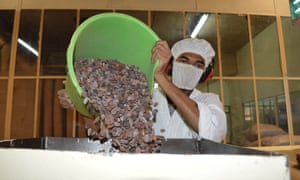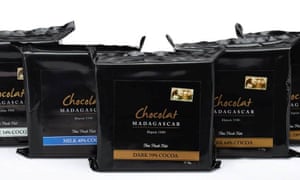Rise of the purists: is chocolate the new coffee?
Growing interest in the origins of chocolate is helping cocoa producers in Ivory Coast and Madagascar gain a bigger slice of the sector’s mega profits

The inside of a cacao seed, from Madagascar, which is used to produce chocolate. Photograph: Chocolat Madagascar
Sunday 4 September 2016 03.00 EDTLast modified on Sunday 4 September 201606.30 EDT
Chocolate is far from a generic product. Madagascan cocoa is fruity, with a slight acidity; cocoa from São Tomé is woody and spicy, while cocoa from Papua New Guinea has musky, leathery undertones.
This uniqueness – and growing interest in it as a selling point to consumers – provides an opportunity for producing countries to gain a bigger proportion of the billion-dollar chocolate industry by expanding the market for single-origin chocolate.
Because of their unique taste profiles, and often small production, single-origin beans command a premium. While beans traded on the commodities exchange currently sell at about $3/kg, François Pralus, a French chocolatier, says that the beans he buys cost from $4.50/kg in Ghana to $11/kg in Venezuela. He also buys them directly from the producer (as is often the case for single-origin chocolate, for issues of traceability), cutting out the middle man.
Although this price premium is positive for cocoa growers, the beans remain a raw material export. The chocolate is then manufactured in Europe or North America, with ingredients (cocoa butter, milk, sugar) sourced elsewhere. Most of the costs are added outside the country of origin; typically, raw ingredients only make up about 3% of a bar’s price.
Some chocolate producers are therefore pushing the concept of single origin further. And it is this that offers the potential for even more of the value of the lucrative chocolate trade to be kept in countries such as Ivory Coast and Madagascar.
What is single-origin chocolate?
The new idea of single-origin chocolate means that all the ingredients in the couverture (the wholesale/bulk cocoa used by chefs, chocolatiers etc) must come from the same country and be processed locally.
Chocolaterie Robert for instance, a chocolate producer based in Madagascar, exports single-origin chocolate products (notably couverture) under the brand name Chocolat Madagascar. They are made from its single-origin beans and manufactured locally. It also sells retail chocolate bars and fine chocolates on the domestic market.
All the ingredients of the Chocolat Madagascar brand are sourced and manufactured locally for domestic markets and export. Photograph: Chocolat Madagascar
“When chocolate is made in the country of origin, it adds value,” says Neil Kelsall, sales and marketing director at Chocolaterie Robert. “More people are employed in the process, the activity generates revenue and raises taxes locally, it has many more benefits for the origin country.”
HB Ingredients, the UK’s largest independent chocolate distributor, started distributing Chocolat Madagascar couverture in 2013. The Madagascan products complement their single-origin couverture range, which also includes chocolate from Colombia and Grenada.
Steve Calver, account manager at HB Ingredients, says that single-origin couverture remains a niche market because of its price and limited production (Chocolaterie Robert for instance produces 280 tonnes of cocoa and Claudio Corallo in São Tomé and Príncipe just 20 tonnes).
But it is growing, he says, partly because of its quality, and partly because ofgreater consumer awareness of what single-origin chocolate means.
Unfortunately, current labelling rules don’t allow consumers to easily distinguish between single-origin chocolate made in the origin country and single-origin chocolate harvested in one country but made elsewhere, so it’s left to manufacturers, distributors and retailers to explain. Chocolat Madagascar uses the Raise Trade label, a movement seeking to positively identify products manufactured in the country of origin.
How can cacao producers benefit?
Over the past three years, Chocolat Madagascar has won a raft of international awards and spurred Chocolaterie Robert to invest in a new plantation. Last year, it bought 1,700 hectares of degraded cocoa plantations from the government. When fully rehabilitated (which will take between five and 10 years), the new plantation should have a production capacity of 600 tonnes, more than double what it was previously, with the prospect of adding to its staff of 70 people.
Chocolat Madagascar is planning to increase production and employment at its facilities in the country. Photograph: Chocolat Madagascar
A number of small chocolate factories have popped up in Peru, Ecuador, Brazil and Vietnam over the past few years, but they remain few and far between, especially in Africa. Calver says that the barriers to entry are high. “Setting up a chocolate factory requires a lot of investment and production knowledge.”
Manufacturing accounts for a great deal of the finished product’s taste so the risk, says Pralus, is to ruin a very good bean with mediocre processing. Starting from scratch is an onerous task, even for experienced hands. Pralus, who has a small cocoa plantation on the island of Nosy Be in north-west Madagascar, says that he gave up on plans to build a chocolate factory there because of the difficult business climate – the country is ranked 164 out of 189 countries for ease of doing business according to the World Bank.
Breaking into new markets is another challenge. In the mid-2000s, Chocolaterie Robert tried but failed to market its retail products in Europe and the US. “That’s how we decided to go for wholesale; it means our investment is about cocoa, not about branding or marketing,” says Kelsall.
Claudio Corallo, the only cocoa grower to also manufacture in São Tomé and Príncipe, says that it is a question of hard work and ultimately, philosophy. “My chocolate is from soil to bar, not bean to bar. It’s something you must nurture from the plant,” he says. On the sustainable dimension of processing chocolate in the country of origin, he says: “People who do the pruning, who deliver, who peel the cocoa beans, they must feel they are part of the machine. Then it becomes sustainable.”


No comments:
Post a Comment